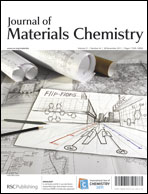Nickel phosphide (Ni2P) hollow spheres were facilely prepared via an organic-phase strategy using nickel(II) acetylacetonate as a metal precursor, trioctylphosphine as a phosphorus source, and octyl ether as solvent. A core/shell-structured Ni2P@C nanocomposite was grown in situ by employing oleylamine and 1-octadecene as capping agent and solvent, respectively, and the hollow Ni2P spheres were homogeneously wrapped by an amorphous carbon shell. The reversible capacity of the Ni2P@C nanocomposite after 50 cycles is 435 mAh g−1 at 0.1 C and 303 mAh g−1 at 0.5 C, respectively, much higher than that of Ni2P (184.2 mAh g−1 at 0.1 C and 123 mAh g−1 at 0.5 C). These improvements are attributed to the carbon shell, which can enhance the conductivity of Ni2P, suppress the aggregation of active particles, and increase their structure stability during cycling.
You have access to this article
 Please wait while we load your content...
Something went wrong. Try again?
Please wait while we load your content...
Something went wrong. Try again?


 Please wait while we load your content...
Please wait while we load your content...